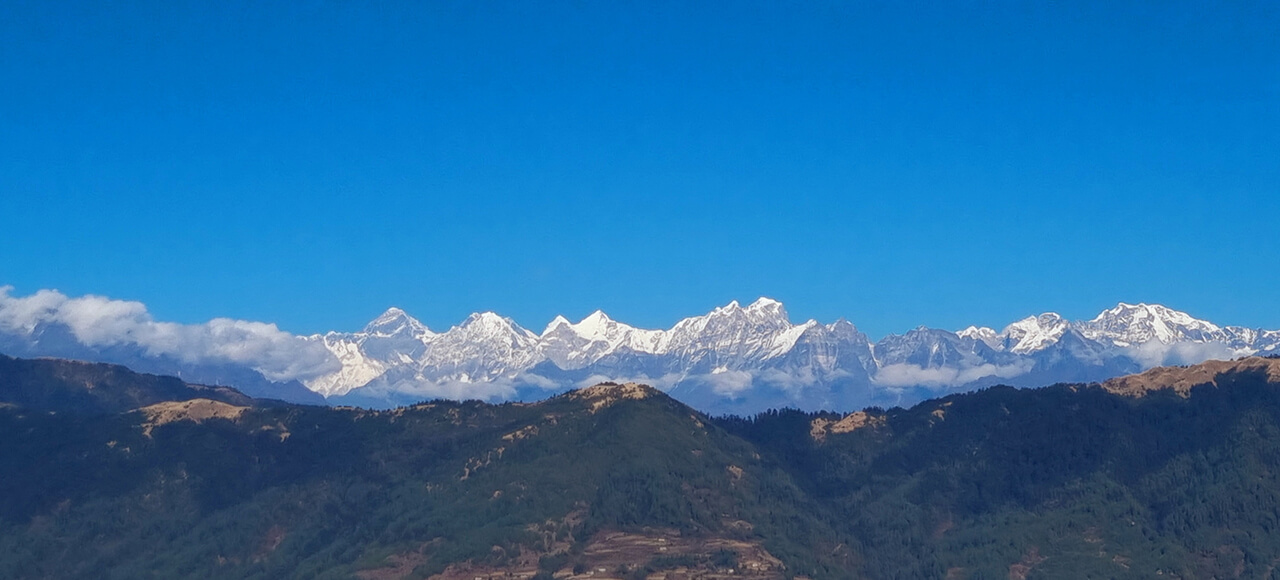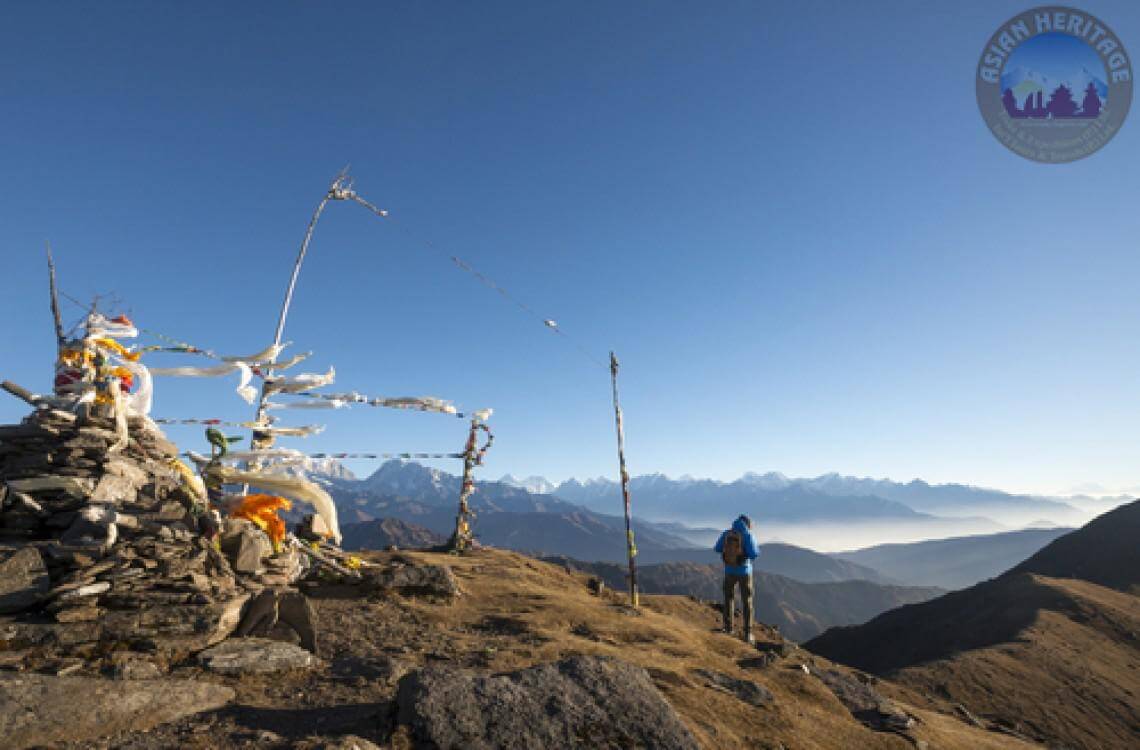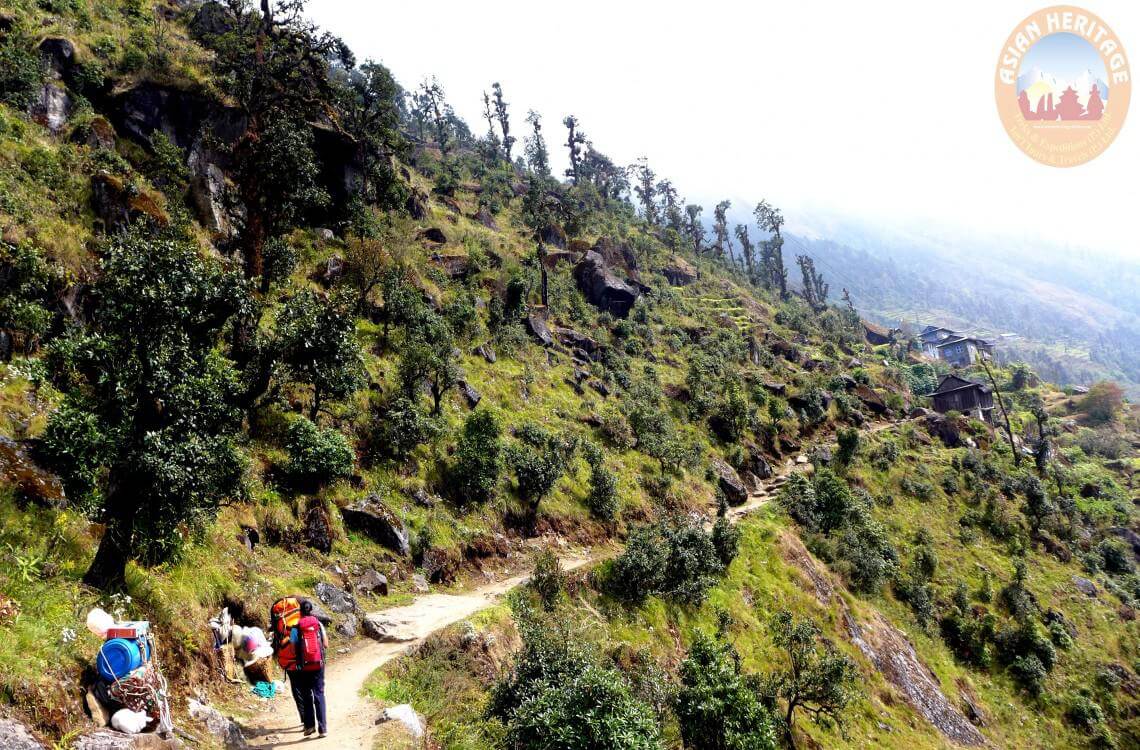The Pikey Peak Trek in February promises an extraordinary experience, combining stunning landscapes, cultural encounters, and the thrill of conquering new heights. Join us as we delve into the captivating journey that awaits those who dare to venture to Pikey Peak in February.
Imagine trekking through a winter wonderland, where snow–clad peaks reach for the heavens and the crisp air invigorates your senses.
Location and Altitude
Pikey Peak is located in the Solu–Khumbu region of eastern Nepal, near the border of the Everest region. It lies in the Solu Rural Municipality of the Solukhumbu District. The trek to Pikey Peak typically starts from
Pikey Peak is located in the Solu–Khumbu region of eastern Nepal, near the border of the Everest region. It lies in the Solu Rural Municipality of the Solukhumbu District. The trek to Pikey Peak typically starts from Jiri, a small town renowned as the gateway to Everest, or from Phaplu, a charming village with a small airport.
Pikey Peak is a spectacular vantage point situated at an altitude of 4,065 meters (13,333 feet) above sea level. While it may not be as towering as some of the renowned Himalayan peaks, the pikey peak trek in February offers an incredible panoramic view of the surrounding mountains that will leave you in awe.
Temperature and Weather Conditions
In February, Pikey Peak experiences the winter season, which means you can expect cold temperatures and varying weather conditions during your trek. It’s important to be prepared for both chilly temperatures and the possibility of snowfall.
Temperature-wise, the daytime temperatures in February at lower elevations around Pikey Peak can range from 5 to 15 degrees Celsius (41 to 59 degrees Fahrenheit). However, as you ascend to higher elevations, the temperatures drop significantly.
Also Read: Tengboche Monastery: The oldest monastery in Khumbu
At night and in the early mornings, temperatures can drop below freezing, reaching as low as –10 degrees Celsius (14 degrees Fahrenheit) or even lower.
Regarding weather conditions, February is considered the dry season in Nepal. However, occasional snowfall and foggy conditions are not uncommon, especially as you gain altitude. The weather can be quite unpredictable in the mountains, so it’s essential to be prepared for sudden changes.
The crowd in Pikey Peak in February
Despite its awe-inspiring beauty, Pikey Peak Trek in February is relatively less crowded compared to other popular trekking routes in Nepal, providing a more serene and peaceful journey.
In February, the crowd in Pikey Peak Trek tends to be moderate, allowing trekkers to enjoy the tranquility of the surroundings. This time of the year falls within the winter season, where the weather can be chilly and the trail might have occasional snowfall. As a result, the number of trekkers is lower compared to the peak tourist seasons of spring and autumn.
Highlights of Pikey Peak Trek in February
While February is considered winter in Nepal, Pikey Peak Trek can still be undertaken with proper preparation and suitable equipment. Here are the highlights of the Pikey Peak Trek in February:
Clear Winter Skies
February offers relatively clear skies during the mornings and early part of the day, providing excellent visibility for mountain views and photography. The crisp winter air enhances the clarity of the distant peaks, making it a photographer’s delight.
Spectacular Mountain Views

Pikey Peak Trek provides breathtaking views of some of the highest mountains in the world. On clear days, you can witness the majestic peaks of Everest (8,848 meters), Kanchenjunga (8,586 meters), Makalu (8,481 meters), Lhotse (8,516 meters), and many others.
Pikey Peak Summit
The main highlight of the Pikey Peak trek in February is reaching the summit of Pikey Peak, which stands at an elevation of 4,065 meters. From the summit, you can witness a mesmerizing sunrise or sunset over the Himalayas, creating a truly unforgettable experience.
Sherpa Culture Trail
The trek takes you through Sherpa villages and their traditional farmlands. You can learn about the Sherpa way of life, witness their farming practices, and even taste local organic produce.
Panoramic Sunrise/Sunset Views
The trek offers several vantage points where you can witness stunning sunrise and sunset views over the Himalayas. The golden hues illuminating the snow-capped peaks create a magical ambiance that is truly awe-inspiring.
You may also like: Busy Tourist Cities of Nepal
Tranquil and Serene Environment
Due to fewer trekkers on the trail during February, you can enjoy a more peaceful and undisturbed trekking experience.
The tranquil environment allows you to connect with nature, rejuvenate your mind, and find solitude amidst the Himalayan wilderness.
Authentic Homestay Experience
Along the Pikey Peak Trek, you’ll find traditional Sherpa and Rai villages that offer homestay accommodations. Staying in these local homes allows you to immerse yourself in the local culture, taste authentic Nepali cuisine, and interact closely with the friendly villagers.
Ancient Buddhist Monasteries

The region is dotted with ancient Buddhist monasteries that hold immense spiritual and cultural significance. You can visit these monasteries, witness daily rituals, and even participate in meditation sessions, gaining insights into the rich Buddhist heritage of the area.
Yak Herds and Yak Cheese
The trekking trail often crosses paths with yak herds grazing in the alpine meadows.

Observing these sturdy animals and learning about their role in the local economy can be a fascinating experience. You may also have the opportunity to taste locally produced yak cheese, which is a specialty of the region.
Pikey Peak Trek Route
Here is a detailed description of the trek route for Pikey Peak:
Kathmandu to Dhap:
The Pikey Peak Trek commences with a delightful journey from Kathmandu to the charming village of Dhap, nestled at an elevation of 2,850 meters (9,350 feet).

The drive itself is a scenic experience, lasting approximately 8-9 hours, as it meanders through breathtaking landscapes and picturesque rural settlements. Upon reaching Dhap, you have the opportunity to explore the village, immerse yourself in its unique atmosphere, and engage with the warm and welcoming local community.
Dhap to Jhapre:
Continuing the trek from Dhap, the path leads to the scenic village of Jhapre, situated at an altitude of 2,940 meters (9,646 feet). The trail treats you to awe-inspiring vistas of the rolling hills and verdant valleys that surround you. Jhapre is a quintessential Sherpa village, offering a genuine cultural experience where you can fully immerse yourself in the local traditions and way of life. It’s an opportunity to embrace the Sherpa culture firsthand and gain a deeper appreciation for their rich heritage.
Jhapre to Pikey Base Camp:
Leaving Jhapre, the trail gradually ascends towards Pikey Base Camp at an altitude of 3,640 meters (11,942 feet). Along the way, you’ll pass through dense forests of rhododendron and oak, as well as terraced farmlands. As you approach the base camp, the panoramic views of the Himalayan peaks, including Mount Everest, become more prominent.
Pikey Base Camp to Pikey Peak Summit and Junbesi:
This is the most exciting day of the trek. Early in the morning, you will hike to the summit of Pikey Peak (4,065 meters/13,335 feet) to witness the stunning sunrise over the Himalayas. The breathtaking panoramic view from the top includes Mount Everest, Makalu, Kanchenjunga, Gauri Shankar, and other snow-capped peaks. After enjoying the view and taking pictures, you’ll descend to Junbesi, a charming Sherpa village known for its Buddhist monasteries.
Junbesi to Thuptenchholing:
From Junbesi, the trail leads downhill through the beautiful Solu Khola Valley. You’ll pass through small villages, terraced fields, and dense forests, immersing yourself in the natural beauty of the region. Eventually, you’ll reach Thuptenchholing, a small village situated at an altitude of 2,780 meters (9,121 feet).
Thuptenchholing to Phaplu:
The trek continues downhill, following the trail along the Solu Khola. You’ll pass through picturesque landscapes, cross suspension bridges, and encounter traditional villages along the way. The day’s trek ends in Phaplu, a bustling town and the administrative center of the Solu Khumbu region.
Popular: Khumbu Glacier Valley: Northeastern Heaven
Phaplu to Kathmandu:
On the final day, you’ll bid farewell to the mountains and take a scenic flight from Phaplu to Kathmandu. The flight offers aerial views of the majestic Himalayas, allowing you to reminisce about the amazing trekking experience you had.
Festivals
In the Pikey Peak region, February is a month of festive spirit as several significant festivals are celebrated during this time. Here are the festivals celebrated in the Pikey Peak region in February:
Lhosar
Lhosar is a significant festival celebrated by the Tamang population in the Pikey Peak region. It serves as the Tibetan New Year and takes place in February. Lhosar is a vibrant and lively celebration characterized by traditional dances, music, cultural performances, and rituals. The participants adorn themselves in colorful traditional attire, creating a vivid and festive atmosphere. During Lhosar, people engage in activities that symbolize purification and the commencement of a prosperous year. The festival is a cherished time for the Tamang community to come together, express their cultural heritage, exchange greetings, and embrace the spirit of a new and fruitful beginning.
Maha Shivaratri
Maha Shivaratri is an important Hindu festival celebrated by the Sherpa and Tamang communities in the Pikey Peak region. This festival is dedicated to Lord Shiva, one of the principal deities in Hinduism. Observed in February or March, Maha Shivaratri is a day of fasting, prayer, and making offerings to Lord Shiva. Devotees visit revered temples like the Tengboche Monastery to engage in religious rituals and seek blessings. The festival holds deep symbolic meaning, representing purification, devotion, and the quest for divine blessings from Lord Shiva. It is a time of spiritual significance and reverence for the Sherpa and Tamang communities in the Pikey Peak region.
Flora

During the Pikey Peak Trek in February, the vegetation of the Solu-Khumbu region in Nepal experiences the winter season. The cold temperatures and occasional snowfall limit the diversity of plant species compared to the lushness of spring and summer. However, there are still several notable plants that you may encounter along the trekking trail. Here are some plants you might see and a brief explanation of each:
Junipers
Juniper trees are evergreen conifers commonly found in the region. They have needle-like leaves and produce small cones. Junipers are well-adapted to withstand the cold and harsh conditions of high-altitude environments. Their presence adds greenery to the landscape even during winter.
Mosses and lichens
Given the moist environment of the region, mosses and lichens thrive on rocks, trees, and forest floors. They add texture and color to the landscape, particularly on damp surfaces. Mosses are small, non-vascular plants, while lichens are symbiotic organisms composed of fungus and algae or cyanobacteria.
More: Upper Mustang Trek in December: Travel Tips, Weather, and More
Ferns
Although ferns may not be as prevalent during winter, you may still come across some species in sheltered and protected areas. Ferns are primitive, non-flowering plants that reproduce via spores. They have delicate, feathery fronds and add a touch of elegance to the forest understory.
Fauna
During the Pikey Peak trek in February, you have the opportunity to spot various animals, although the specific sightings may vary depending on factors such as weather conditions and the time of day. Here are some animals you may encounter during the trek:
Himalayan Monal
This stunning bird is the national bird of Nepal and is known for its vibrant and colorful plumage. It can be spotted in the forests and meadows around Pikey Peak.
Snow Leopard

Although rare to spot, the snow leopard inhabits the higher altitudes of the Himalayas. Its elusive nature and excellent camouflage make it challenging to observe, but if you’re lucky, you might catch a glimpse of this majestic big cat.
Red Panda
Another elusive creature, the red panda is an arboreal mammal found in the eastern Himalayas. Known for its distinctive reddish-brown fur and bushy tail, it primarily resides in dense bamboo forests.
Himalayan Black Bear
The Himalayan Black Bear is an indigenous species exclusive to the Himalayas and is typically seen at lower to mid-level altitudes. While it generally steers clear of human interaction, it is relatively rare to encounter its footprints or signs while trekking.
Himalayan Tahr
The Himalayan Tahr, known for its sure-footedness, thrives in the rocky terrain of the Himalayan hillsides. These resilient ungulates can often be observed grazing in alpine meadows and steep slopes, adorned with their thick coats and distinctive curved horns.
Difficulty Level of Pikey Peak Trek in February
The level of difficulty for the Pikey Peak Trek in February can fluctuate depending on a range of factors, such as weather conditions, individual fitness level, and prior trekking experience. During this time, the Pikey Peak area experiences winter conditions. In February, the weather can be cold, with temperatures dropping below freezing, particularly at higher altitudes. Snowfall is frequent, and the trails may be covered in snow, posing hazards and creating difficulties for walking. The combination of frigid weather and snowy conditions amplifies the challenges of the journey.
Read: Best time to do Upper Mustang Trek
Physical fitness is crucial for any trek, including Pikey Peak. The trek involves walking for several hours each day, and the trails can be steep and challenging. Having a good level of cardiovascular fitness, endurance, and strength will make the trek more manageable. Regular exercise and hiking practice before the trek can significantly enhance your overall experience.
Side Treks
While the main highlight of the Pikey Peak Trek is reaching the summit of Pikey Peak itself, there are several favorable side treks that can be done in February, adding more adventure and diversity to your journey.
Here are some of the favorable side treks you can consider during your Pikey Peak Trek in February:
Junbesi and Thuptenchholing Monastery
Junbesi is a picturesque Sherpa village located on the way to Pikey Peak. It is home to the Thuptenchholing Monastery, an important religious site in the region. The trek to Junbesi allows you to immerse yourself in Sherpa culture and witness the daily lives of the local people. The monastery offers a peaceful and spiritual ambiance, and you can explore the monastery complex and interact with the resident monks.
Chiwong Monastery
Another significant monastery in the area is Chiwong Monastery, situated near Taktor village. This side trek takes you through rhododendron forests and offers magnificent views of the Himalayan range. The Chiwong Monastery itself is perched on a hilltop, and you can spend time meditating or simply enjoying the tranquility of the surroundings.
Pike Dudh Kunda Trail
If you are up for a longer and more challenging side trek, you can consider the Pike Dudh Kunda Trail. This trek takes you to the sacred lake of Dudh Kunda (Milk Lake) and offers breathtaking views of the mountains along the way. Dudh Kunda is a pilgrimage site for both Hindus and Buddhists, and it holds religious significance. The trek passes through remote Sherpa villages, yak pastures, and high–altitude landscapes, providing a unique and rewarding experience.
Numbur Cheese Circuit
The Numbur Cheese Circuit is another option for a side trek during the Pikey Peak Trek. This circuit trail is famous for its cheese production and showcases the rural lifestyle of the local Sherpa community. You can visit the Numbur Cheese Factory, learn about traditional cheese-making techniques, and taste the delicious local cheese. The trek also offers stunning views of Numbur and Kongde peaks and takes you through beautiful valleys and alpine forests.
Let our expert team at Asian Heritage Treks and Travel take care of everything — from guided tours to personalized packing tips and travel arrangements.
Plan an exciting trip







